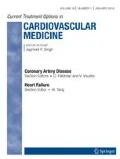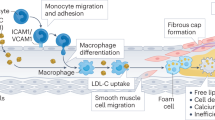Opinion statement
Several treatment strategies, including lowering low-density lipoprotein cholesterol with intensive statin therapy, reducing triglycerides with fibrates, and raising high-density lipoprotein cholesterol with nicotinic acid, have the potential to induce atherosclerosis regression. Atherosclerosis imaging techniques including intravascular ultrasound, carotid ultrasound to measure carotid intima-media thickness, and cardiovascular MRI are established modalities for describing longitudinal changes in the quantity and quality of atherosclerotic plaque. An increasing number of clinical trials are using radiologic measures of subclinical atherosclerosis as surrogate end points in lieu of the traditional “hard” end points of myocardial infarction and death. This approach has great appeal, as improvements in atherosclerosis imaging now enable the characterization of early atheromas and positive remodeling within the vessel wall before the plaque becomes obstructive. Additional prospective data correlating these surrogate end points with hard outcomes are needed to determine whether atherosclerosis regression will be the major determinant of future treatment strategies.
Similar content being viewed by others
References and Recommended Reading
National Cholesterol Education Program: Third report of the National Cholesterol Education Program (NCEP) Expert Panel on Detection, Evaluation, and Treatment of High Blood Cholesterol in Adults (Adult Treatment Panel III) final report. Circulation 2002, 106:3143.
Grundy SM, Cleeman JI, Merz CN, et al.: Implications of recent clinical trials for the National Cholesterol Education Program Adult Treatment Panel III guidelines. Circulation 2004, 110:227–239.
Mudd JO, Borlaug BA, Johnston PV, et al.: Beyond low-density lipoprotein cholesterol: defining the role of low-density lipoprotein heterogeneity in coronary artery disease. J Am Coll Cardiol 2007, 50:1735–1741.
Nicholls SJ, Tuzcu EM, Sipahi I, et al.: Statins, high-density lipoprotein cholesterol, and regression of coronary atherosclerosis. JAMA 2007, 297:499–508.
Brown BG, Zhao X-Q, Chait A, et al.: Simvastatin and niacin, antioxidant vitamins, or the combination for the prevention of coronary disease. N Engl J Med 2001, 345:1583–1592.
Taylor A, Shae LJ, Fayad Z, et al.: Tracking atherosclerosis regression: a clinical tool in preventative cardiology. Atherosclerosis 2005, 180:1–10.
Raggi P, Taylor A, Fayad Z, et al.: Atherosclerotic plaque imaging: contemporary role in preventive cardiology. Arch Intern Med 2005, 165:2345–2353.
Glagov S, Weisenberg E, Zarins CK, et al.: Compensatory enlargement of human atherosclerotic coronary arteries. N Engl J Med 1987, 316:1371–1375.
Schoenhagen P, Ziada KM, Kapadia SR, et al.: Extent and direction of arterial remodeling in stable versus unstable coronary syndromes: an intravascular ultrasound study. Circulation 2000, 101:598–603.
Kozuma K, Regar E, Bruining N, et al.: Sensitivity and specificity of QCA in detecting coronary arterial remodeling after intracoronary brachytherapy: a comparison to serial volumetric three-dimensional intravascular ultrasound analysis. Can we detect positive remodeling by luminography? J Invasive Cardiol 2003, 15:636–640.
Loscalzo J: Clinical trials in cardiovascular medicine in an era of marginal benefit, bias, and hyperbole. Circulation 2005, 112:3026–3029.
Brown BG, Bolson E, Frimer M, Dodge HT: Quantitative coronary arteriography: estimation of dimensions, hemodynamic resistance, and atheroma mass of coronary artery lesions using the arteriogram and digital computation. Circulation 1977, 55:329–337.
Waters D, Craven TE, Lesperance J: Prognostic significance of progression of coronary atherosclerosis. Circulation 1993, 87:1067–1075.
Buchwald H, Matts JP, Fitch LL, et al.; Surgical Control of the Hyperlipidemias (POSCH) Group: Changes in sequential coronary arteriograms and subsequent coronary events. JAMA 1992, 268:1429–1433.
Azen SP, Mack WJ, Cashin-Hemphill L, et al.: Progression of coronary artery disease predicts clinical coronary events. Long-term follow-up from the Cholesterol Lowering Atherosclerosis Study. Circulation 1996, 93:34–41.
Brown BG, Albers JJ, Fisher LD, et al.: Regression of coronary artery disease as a result of intensive lipid-lowering therapy in men with high levels of apolipoprotein B. N Engl J Med 1990, 323:1289–1298.
Blankenhorn DH, Azen SP, Kramsch DM, et al.; MARS Research Group: Coronary angiographic changes with lovastatin therapy: the Monitored Atherosclerosis Regression Study (MARS). Ann Intern Med 1993, 119:969–976.
Walters D, Higginson L, Gladstone P, et al.: Effects of monotherapy with an HMG-CoA reductase inhibitor on the progression of coronary atherosclerosis as assessed by serial quantitative arteriography. The Canadian Coronary Atherosclerosis Intervention Trial. Circulation 1994, 89:959–968.
The MAAS Investigators: Effect of simvastatin on coronary atheroma: the Multicentre Anti-Atheroma Study (MAAS). Lancet 1994, 344:633–638.
Pitt B, Mancini GB, Ellis SG, et al.: Pravastatin limitation of atherosclerosis in the coronary arteries (PLAC I): reduction in atherosclerosis progression and clinical events. PLAC I investigation. J Am Coll Cardiol 1995, 26:1133–1139.
Jukema JW, Bruschke QV, van Boven AJ, et al.: Effects of lipid lowering by pravastatin on progression and regression of coronary artery disease by symptomatic men with normal to moderately elevated serum cholesterol levels. The Regression Growth Evaluation Statin Study (REGRESS). Circulation 1995, 91:2528–2540.
Herd JA, Ballyntyne CM, Farmer JA, et al.: Effects of fluvastatin on coronary atherosclerosis in patients with mild to moderate cholesterol elevations (Lipoprotein and Coronary Atherosclerosis Study [LCAS] ). Am J Cardiol 1997, 80:278–286.
Brown BG, Zhao X-Q: A direct comparison of intravascular ultrasound and quantitative coronary angiography: implications for measures of atherosclerosis as clinical surrogates. Circulation 2007, 115:1824–1826.
Topol EJ, Nissen SE: Our preoccupation with coronary luminography. The dissociation between clinical and angiographic findings in ischemic heart disease. Circulation 1995, 92:2333–2342.
Siphai I, Tuzcu EM, Schoenhagen P, et al.: Compensatory enlargement of human coronary arteries during progression of atherosclerosis in unrelated to atheroma burden: serial intravascular ultrasound observations from the REVERSAL trial. Eur Heart J 2006, 27:1664–1670.
Ballantyne CM, Herd JA, Ferlic LL, et al.: Influence of low HDL on progression of coronary artery disease and response to fluvastatin therapy. Circulation 1999, 99:736–743.
Bose D, von Birgelen C, Erbel R: Intravascular ultrasound for the evaluation of therapies targeting coronary atherosclerosis. J Am Coll Cardiol 2007, 49:925–932.
Mintz GS, Nissen SE, Anderson WD, et al.: American College of Cardiology clinical expert consensus document on standards for acquisition, measurement and reporting of intravascular ultrasound studies (IVUS). A report of the American College of Cardiology Task Force on Clinical Expert Consensus Documents. J Am Coll Cardiol 2001, 37:1478–1492.
Yamagishi M, Terashima M, Awano K, et al.: Morphology of vulnerable coronary plaque: insights from follow-up of patients examined by intravascular ultrasound before an acute coronary syndrome. J Am Coll Cardiol 2000, 35:106–111.
Konig A, Klauss V: Virtual histology. Heart 2007, 93:977–982.
Blumenthal RS, Kapur NK: Can a potent statin actually regress coronary atherosclerosis? JAMA 2006, 295:1583–1584.
von Birgelen C, Hartmann M, Mintz GS, et al.: Relationship between cardiovascular risk as predicted by established risk scores versus plaque progression as measured by serial intravascular ultrasound in left main coronary arteries. Circulation 2004, 110:1579–1585.
Nissen SE, Tuzcu EM, Libby P, et al.: Effect of antihypertensive agents on cardiovascular events in patients with coronary disease and normal blood pressure: the CAMELOT study: a randomized controlled trial. JAMA 2004, 292:2217–2225.
Nissen SE, Tuzcu EM, Schoenhagen P, et al.: Effect of intensive compared with moderate lipid-lowering therapy on progression of coronary atherosclerosis: a randomized controlled trial. JAMA 2004, 291:1071–1080.
Nissen SE, Nicholls SJ, Sipahi I, et al.: Effect of very high-intensity statin therapy on regression of coronary atherosclerosis: the ASTEROID trial. JAMA 2006, 295:1556–1565.
Sipahi I, Nicholls SJ, Tuzcu EM, Nissen SE: Coronary atherosclerosis can regress with very intensive statin therapy. Cleve Clin J Med 2006, 73:937–944.
Nissen SE, Tsunoda T, Tuzcu EM, et al.: Effect of recombinant apoA-I Milano on coronary atherosclerosis in patients with acute coronary syndromes: a randomized controlled trial. JAMA 2003, 290:2292–2300.
Barter PJ, Caulfield M, Eriksson M, et al.: Effects of torcetrapib in patients at high risk for coronary events. N Engl J Med 2007, 357:2109–2122.
Nissen SE, Tardif JC, Nicholls SJ, et al.: Effect of torcetrapib on the progression of coronary atherosclerosis. N Engl J Med 2007, 356:1304–1316.
Bots ML, Evans GW, Riley WA, et al.: Carotid intima-media thickness measurements in interventional studies: design options, progression rates, and sample size considerations: a point of view. Stroke 2003, 34:2985–2994.
Chambless LE, Heiss G, Folsom AR, et al.: Association of coronary heart disease incidence with carotid arterial wall thickness and major risk factors: the Atherosclerosis Risk in Communities (ARIC) study, 1987–1993. Am J Epidemiol 1997, 146:483–494.
Chambless LE, Folsom AR, Clegg LX, et al.: Carotid wall thickness is predictive of incident clinical stroke: the Atherosclerosis Risk in Communities (ARIC) study. Am J Epidemiol 2000, 151:478–487.
O’Leary DH, Polak JF, Kronmal RA, et al.: Cardiovascular Health Study Collaborative Research Group: Carotid artery intima and media thickness as a risk factor for myocardial infarction and stroke in older adults. N Engl J Med 1999, 340:14–22.
Bots ML, Hoes AW, Koudstaal PJ, et al.: Common carotid artery intima-media thickness and risk of stroke and myocardial infarction: the Rotterdam Study. Circulation 1997, 96:1432–1437.
Blankenhorn DH, Seltzer RH, Crawford DW, et al.: Beneficial effects of colestipol-niacin therapy on carotid atherosclerosis: two-and four-year reduction of intima-media thickness measured by ultrasound. Circulation 1993, 88:20–28.
Taylor AJ, Sullenberger LE, Lee HJ, et al.: Arterial Biology for the Investigation of the Treatment Effects of Reducing Cholesterol (ARBITER) 2: a double-blind, placebo-controlled study of extended-release niacin on atherosclerosis progression in secondary prevention patients treated with statins. Circulation 2004, 110:3512–3517.
Crouse JR 3rd, Raichlen JS, Riley WA, et al.: Effect of rosuvastatin on progression of carotid intima-media thickness in low-risk individuals with subclinical atherosclerosis: the METEOR trial. JAMA 2007, 297:1344–1353.
Desai MY, Bluemke DA: Atherosclerosis imaging using MR imaging: current and emerging applications. Magn Reson Imaging Clin N Am 2005, 13:171–180, vii.
Fayad ZA, Fuster V, Nikolaou K, Becker C: Computed tomography and magnetic resonance imaging for noninvasive coronary angiography and plaque imaging: current and potential future concepts. Circulation 2002, 106:2026–2034.
Corti R, Fayad ZA, Fuster V, et al.: Effects of lipid-lowering by simvastatin on human atherosclerotic lesions: a longitudinal study by high-resolution, noninvasive magnetic resonance imaging. Circulation 2001, 104:249–252.
Corti R, Fuster V, Fayad ZA, et al.: Lipid lowering by simvastatin induces regression of human atherosclerotic lesions: two years’ follow-up by high-resolution noninvasive magnetic resonance imaging. Circulation 2002, 106:2884–2887.
Corti R, Fuster V, Fayad ZA, et al.: Effects of aggressive versus conventional lipid-lowering therapy by simvastatin on human atherosclerotic lesions: a prospective, randomized, double-blind trial with high-resolution magnetic resonance imaging. J Am Coll Cardiol 2005, 46:106–112.
Lima JA, Desai MY, Steen H, et al.: Statin-induced cholesterol lowering and plaque regression after 6 months of magnetic resonance imaging-monitored therapy. Circulation 2004, 110:2336–2341.
Yonemura A, Momiyama Y, Fayad ZA, et al.: Effect of lipid-lowering therapy with atorvastatin on atherosclerotic aortic plaques detected by noninvasive magnetic resonance imaging. J Am Coll Cardiol 2005, 45:733–742.
Ayaori M, Momiyama Y, Fayad ZA, et al.: Effect of bezafi- brate therapy on atherosclerotic aortic plaques detected by MRI in dyslipidemic patients with hypertriglyceridemia. Atherosclerosis 2008, 196:425–433.
Kim WY, Stuber M, Börnert P, et al.: Three-dimensional black-blood cardiac magnetic resonance coronary vessel wall imaging detects positive arterial remodeling in patients with nonsignificant coronary artery disease. Circulation 2002, 106:296–299.
Desai MY, Lai S, Barmet C, et al.: Reproducibility of 3D free-breathing magnetic resonance coronary vessel wall imaging. Eur Heart J 2005, 26:2320–2324.
Frias JC, Williams KJ, Fisher EA, Fayad ZA: Recombinant HDL-like nanoparticles: a specific contrast agent for MRI of atherosclerotic plaques. J Am Chem Soc 2004, 126:16316–16317.
Winter PM, Morawski AM, Caruthers SD, et al.: Molecular imaging of angiogenesis in early-stage atherosclerosis with alpha(v)beta3-integrin-targeted nanoparticles. Circulation 2003, 108:2270–2274.
Author information
Authors and Affiliations
Corresponding author
Rights and permissions
About this article
Cite this article
Thompson, J.B., Blaha, M., Resar, J.R. et al. Strategies to reverse atherosclerosis: An imaging perspective. Curr Treat Options Cardiovasc Med 10, 283–293 (2008). https://doi.org/10.1007/s11936-008-0049-2
Issue Date:
DOI: https://doi.org/10.1007/s11936-008-0049-2




